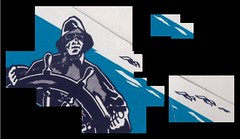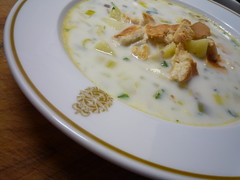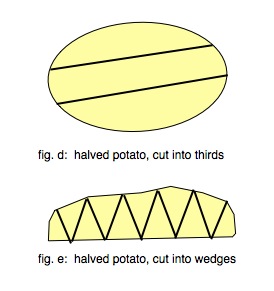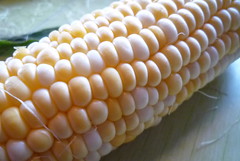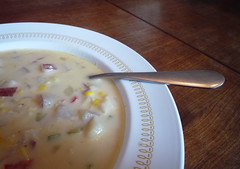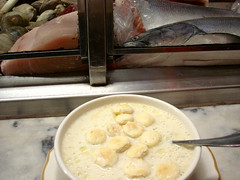Cape Cod Capers
 fig. a: geography
fig. a: geography
Ah, Cape Cod! Your sandy features and abundant coastline hold so many opportunities, so many pleasures! And your lobsters are so disproportionately large (and tasty)!
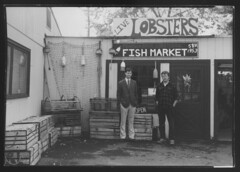 fig. b: nostalgia
fig. b: nostalgia
We're already so nostalgic for you. It's only been a little over a week since we returned, but it feels like decades.
fig. c: dunes
We miss your sand dunes and your foliage,
 fig. d: ark
fig. d: arkyour quaint little towns and villages with their whimsical sense of style,
 fig. e: shells
fig. e: shellsand your abundant beachcombing opportunities.
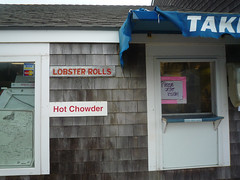 fig. f: lobstah & chowdah
fig. f: lobstah & chowdahBut most of all we miss your seafood stores and markets. Places like Hatch's, Mac's, the Chatham Fish Pier Market, and George's (motto: "George's plaice has sole."), with their lobster rolls, their beautiful fresh and smoked fish, their briny, inexpensive Wellfleet oysters, and their luscious littlenecks
 fig. g: steamahs
fig. g: steamahsand succulent (and sometimes even sandless!) steamers. Because of you, we ate plentiful seafood each and every day, and in every possible way: raw, steamed, grilled, pan-fried, etc.
We knew we'd miss your seafood, so we brought some home with us
 fig. h: sea food
fig. h: sea foodin those lovely lined bags of yours. We brought back delicious flounder and smoked bluefish, but we were especially excited to be bringing back clams:
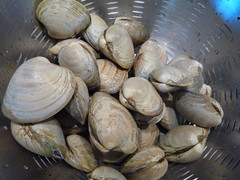 fig. i: littlenecks
fig. i: littlenecksboth littlenecks
 fig. j: steamahs
fig. j: steamahsand steamers. You see, we had it in mind to make some real clam chowder, so we made sure to pick up the other essentials that are so critical to good, old-fashioned chowder-making:
 fig. k: bacon
fig. k: baconsmoky bacon (from New Hampshire),
 fig. l: potatoes
fig. l: potatoesseasonal potatoes (from Quebec), and milk and cream (from Vermont).
You can find clam chowder all up and down the Cape, of course, but it's a little difficult to find one to our liking. The regional preference is for starchy, even stodgy, clam chowder that's heavy with thickeners, but we prefer ours thinner and lighter, with any and all starchiness coming strictly from the potatoes and any crackers or pilot biscuits you might choose to top it off with. The trick is to chop up your potatoes "thick/thin": in irregular shapes that are narrower at one end and that cook irregularly. If you chop 'em and cook 'em just right, the potatoes themselves will thicken your chowder just so.
Clam Chowder
36 littleneck clams*
125 ml high-quality clam juice [like Bar Harbor] (optional)
4 strips smoky bacon
1 sweet onion, finely chopped
water or high-quality clam juice
9-10 small-medium potatoes, cut thick-thin
1 1/2 cups whole milk
1/2 cup cooking cream
salt and freshly ground black pepper to taste
common crackers (optional, but highly recommended)
If you want a particularly rich clam broth, pour 250 ml of clam juice in a large pot, add the clams, cover the pot, and bring to a boil. When the liquid comes to a boil, lower the heat, and steam the clams until they've all opened (about 6-10 minutes).
If you don't have access to a high-quality clam juice, just use the same amount of water instead, and follow the directions above.
When the clams have opened, use tongs to place them in a bowl. And when the clams have cooled enough to handle, remove the clam meat from its shell and chop finely.
Strain the liquid in the pot along with any broth in the bowl through a fine strainer lined with a paper coffee filter, or just pour it off carefully, leaving the grit behind.
Fry the bacon in a pan until crispy. Pour the bacon fat into a pot and sauté the onion until translucent. Meanwhile, dice the bacon.
Measure the amount of broth and top off with water or clam juice to make a generous 2 cups. Add this to the pot with the onion, as well as the diced bacon. Add the potatoes, bring to a simmer, and cook until they are still firm but done. Stir the milk and cream into the broth and add salt and pepper as necessary. If your clams are fresh and briny and if you've used clam juice, you shouldn't need much, if any, salt.
Bring the broth back to a gentle simmer and add the clam meat. Do not let the chowder boil. Cook the chowder at the barest simmer for another 2-3 minutes.
The chowder will be at its best if you age it briefly, keeping it warm, but not hot, for an hour or so. Afterwards, just bring the chowder bring it back to temperature, adjust the seasoning, and serve, preferably with common crackers (especially common crackers that have been split and toasted in the oven.)
Serves 4-6 as an opening course.
[recipe based closely on a recipe from John Thorne's Serious Pig]
* You can also make a nice clam chowder with steamers, but we saved our steamers for, well..., steaming.The other revelation of our Cape Cod excursion had to do not with fruits de mer, but with fruits du bord de la mer.
Michelle had read about Cape Cod's legendary beach plums years ago. When we we got an invitation to vacation there, she tried to find out some more about them and discovered that we'd be there at the height of their season--mid- to late-August. The thing is, how do you go about finding a fruit that's totally wild and that you can only procure from foragers? Especially when the foragers in question are known to keep their sources secret--like mushroom hunters and their troves of prized chanterelles and morels.
We had no idea how we'd find beach plums, but we were determined to keep our eyes peeled for them. And, in the end, it took us less than 24 hours to score both beach plums and another wild coastal fruit we had no idea even existed: wild apricots. But we found in them in a most unlikely spot: at a flea market (!).
We'd been told that the weekend flea market at the Wellfleet Drive-In was a must--and it was!--but we had no idea that there'd be a grizzled old hippie selling foraged fruit along with his carved wood C.R.A.P.** God bless him! He had an amazing array of carved driftwood whales and other folk art treasures, and his beach plums and wild apricots were beautiful (much, much smaller than we would have imagined, but beautiful nonetheless).
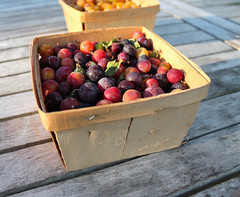
fig. m: wild beach plums & apricots
When we got them back to our beach house,
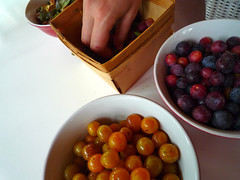
fig. n: sorting
Michelle set about sorting through them. And the next morning she made an exceedingly precious
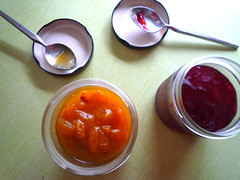 fig. o: preserves
fig. o: preservessmall batch of wild apricot and beach plum preserves. Fresh, both fruit were a little too tart to be pleasant--but sweetened and cooked, they turned into the deepest, most delicious preserves. The beach plums almost had a wine flavour to them, while the apricots were redolent of almond.
We brought back numerous souvenirs from our trip to Cape Cod,
 fig. p: souvenirs
fig. p: souvenirs fig. q: ole no. 69
fig. q: ole no. 69but there's no question the most highly prized were those two jars of beach house-made preserves.
Of course, there are other, more conventional ways of scoring traditional Cape Cod preserves, like beach plum. And some of them are quite excellent, indeed. Take the Chatham Jam and Jelly Shop,
 fig. r: jams & jellies
fig. r: jams & jelliesin (you guessed it!) Chatham, where you can find dozens upon dozens of house-made jam & jellies, including a whole assortment of wild fruit preserves.
We kept the small batch we made at the beach house for ourselves, but we brought back extras to stock our pantry and give to our friends and family.
Ah, Cape Cod! We miss you so.
aj
** The acronym stands for Cape Recycled Art Project, if memory serves me right.
p.s. TY to R & MA for making this happen--such a great time!

